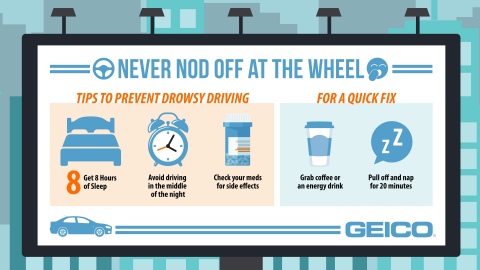As the clocks fall back, the amount of daylight starts to dwindle. While drivers spend more time in the dark over the fall and winter months, GEICO has the following reminders to help them avoid becoming drowsy behind the wheel.
 GEICO graphic with reminders about the dangers of driving while drowsy (Graphic: GEICO)
GEICO graphic with reminders about the dangers of driving while drowsy (Graphic: GEICO)- Catch enough Z’s: It’s important for adults to get eight hours of sleep a night according to the National Institutes of Health. Getting behind the wheel while sleep deprived makes it harder for drivers to focus, and can lead to difficulties reacting to hazards in the road and changes in traffic.
- Limit driving during peak sleepiness periods:Drowsiness is more likely to set in during the hours between midnight and 6 a.m. according to the National Highway Traffic Safety Administration (NHTSA). If drivers need to head out at this time, they should remain vigilant for signs of drowsiness such as crossing lines or hitting rumble strips.
- Check medications: Both prescription and over-the-counter medications could cause drowsiness as a side effect. NHTSA recommends using public transportation when possible if you take medicine that causes noticeable drowsiness.
- Take a break: If your eyes start to get heavy in the driver’s seat, avoid trying to fight through it. Pull off to a safe spot such as a rest stop and nap for 20 minutes, or switch drivers if you have a passenger with you.
- Recharge with a beverage: Sipping on coffee or an energy drink can provide a quick fix to feeling drowsy; however, it may only deliver temporary relief.
For more safe driving tips, visit GEICO’s Safe Driving Resources page.
No comments:
Post a Comment
Note: Only a member of this blog may post a comment.